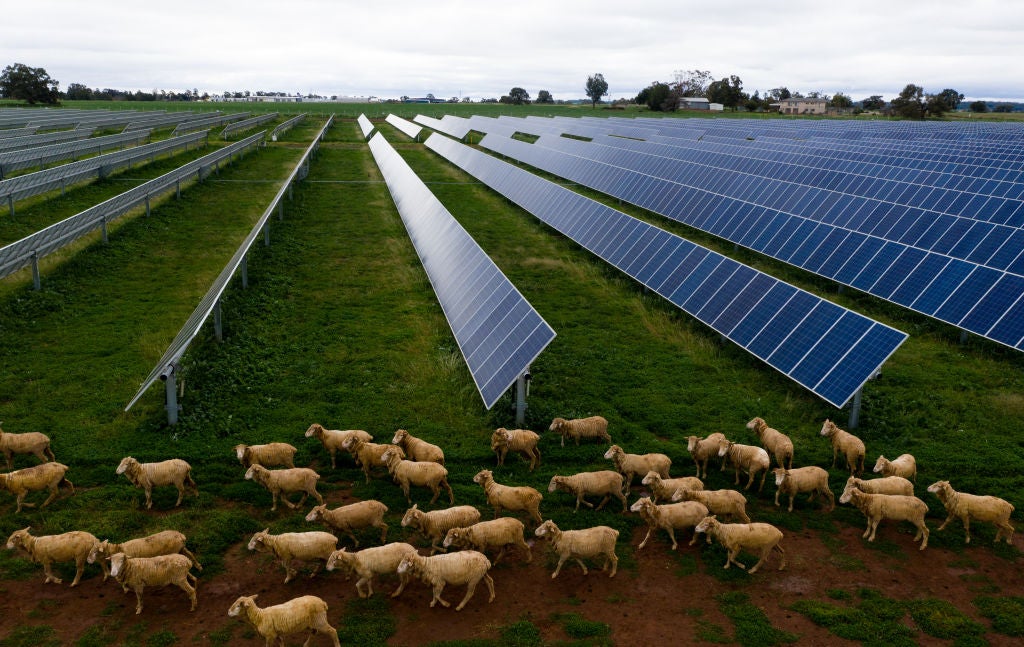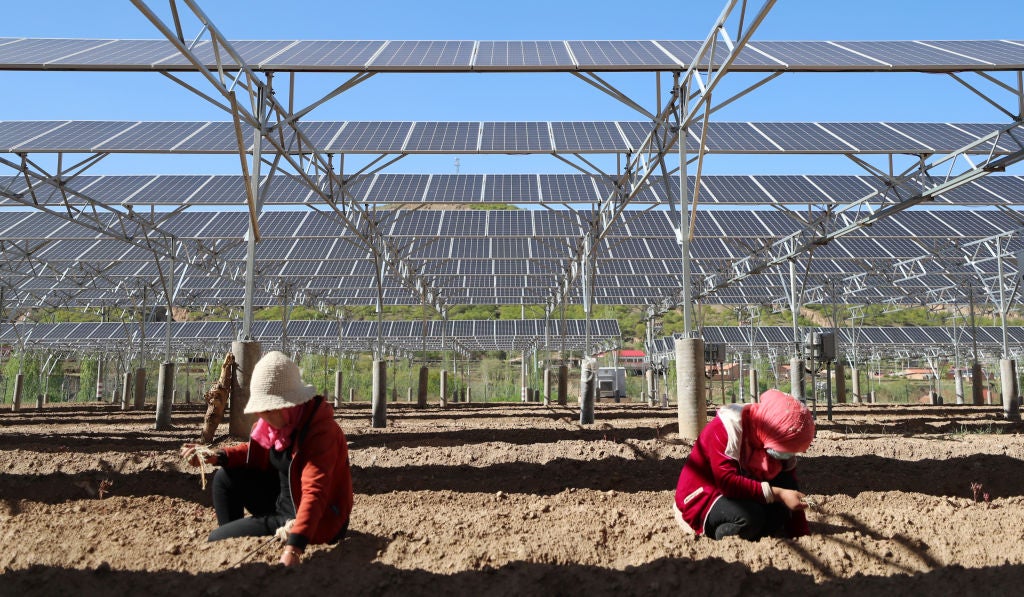Sun Power, Profits for Farmers: Solar Energy is Reshaping Agriculture
Times are tough for UK farmers. A lack of seasonal workers due to Brexit and Covid has left fruit rotting in fields and tens of thousands of pigs needing to be culled. Meanwhile, food and drink exports were down 50% in the first quarter of 2021, the first year of Brexit proper, and soaring gas prices have led to a shortage of fertiliser worldwide – and this is all in addition to long-term pressures on farms from supermarket price wars.
“It is very difficult to provide our fruit to a high standard year-in, year-out, at the minimum price expected by the big supermarkets,” says Gordon Derbyshire, who farms 100 acres of apple trees near the town of Tunbridge Wells in south-east England. Matters are made more difficult by the fact that his farm does not have particularly fertile soil and, being at the bottom of a hill, a high frost risk.

Five years ago, Derbyshire leased 31 acres of land to French power company Engie. The company installed 5MW of solar panels, which are linked to an electricity grid mainline that happens to pass through the farmer’s land. “We have a long-term contract so that on a good year, the apples might do better, but on a bad year, the panels do better. It is reliable and it works well for us,” Derbyshire says. There are two other solar farms within ten miles, he adds, and his family is looking to lease more land to renewables developers in future, such is their satisfaction with how things have gone.
Some 75% of the UK’s land is farmland. This typically flat, open land is also best suited to renewables. To accelerate the energy transition enough for net zero by 2050, more and more farmers will have to offer up their land for renewable power. In 2019, around 40% of farmers were already generating low-carbon energy, says the UK National Farmers’ Union. This produced around 10% of the UK’s electricity needs and encompassed 70% of UK solar power.
Of course, developing solar power is not the only way that farmers can work to combat the climate crisis. There is also the thorny issue of decarbonising agricultural operations, collectively responsible for around 10% of UK emissions, as well as agricultural practices like the anaerobic digestion of organic waste to produce biogas or the growing of biofuel feedstocks like rapeseed or beets. However, rural solar power is an intriguing concept, both because of the economic opportunity presented by the massive scale-up net zero requires and long-held concerns that photovoltaic panels will take up too much land and could threaten the traditional agriculture sector.
When farmers decide to develop solar assets, they have two main options: lease land to solar developers or to produce solar power themselves. Between 2010 and 2019, the latter option was often deemed more profitable, because the UK feed-in tariff (FiT) saw the government pay generators of less than 5MW a guaranteed rate for supplying renewable power to the grid. Over the course of the FiT, 5,127MW of solar power and 770MW of wind power were guaranteed support for a period of 20–25 years.

US Tariffs are shifting - will you react or anticipate?
Don’t let policy changes catch you off guard. Stay proactive with real-time data and expert analysis.
By GlobalDataJames Smith is managing director at Loddington Farm, another fruit farm in Kent, which has a 29kW solar array and an 11kW wind turbine. “I would not have invested in the schemes without the FiT incentives,” Smith says, explaining that the farm receives a small payment for a 50% share of power generated being exported to the grid.
With the government no longer issuing new FiTs, it has become harder for farmers to invest in their own small-scale renewables. Smith can understand why other farmers might now be leasing land to energy companies instead. “Growing crops is high risk and low reward, whereas solar is low risk and high reward,” he says. Farmers can lease an acre to renewables developers like RES, Engie or Vattenfall for more than £1,000 a year – a price that can make crops “look ridiculous” by comparison, Smith says.
Maximising PPA profits
Whether it is energy companies or the farmers themselves generating power on farmland, money is normally earned by selling that power to a utility or other buyer via a power purchase agreement (PPA). These allow generators to sell their electricity over an agreed period. They can be fixed price PPAs, which lock in the current market rate, or flexible, allowing the seller to trade power at different times and profit from price changes on the wholesale market.
Flexible PPAs offer independent producers a chance to boost their profits, but the technical challenge of selling at the right moment to the right utility can be daunting. Kristina Rabecaite, a London-based Lithuanian emigré in her late twenties, has come up with a solution for this, however, in the form of an app called PPAYA, which monitors and analyses prices on the day-ahead wholesale market on behalf of independent producers, so they can get the best deal.
The app allows independent producers, many of which are farmers, to set a target price, and highlights the likelihood of achieving that price. Once set up, it will automatically hold the producer’s tenders every day of the year to try and meet that price, also opening the tender to multiple utilities so the producer can access the most profitable contract each time.
“In future, when feed-in-tariffs expire, farmers will have to rely on purely market prices for income; PPAYA will allow them to maximise their income,” says Rabecaite. Her team is increasingly being approached by a new generation of farmers investing in subsidy-free, larger-scale assets, who are aiming to take advantage of the low cost of renewables and the current high electricity prices.
“We are not experts in the sale of our electricity,” says Ian Williams, an arable farmer in Shropshire in the West Midlands, who exports 735kWh of electricity per day. “All that signing up to PPAYA involved was choosing a reserve price we were happy with. We have since achieved the best prices we have ever had.”
Other markets: Germany and the US
The dual phenomenon of farmers under pressure and renewables needing scale-up exists across the world, not just in the UK. In Germany, the feed-in tariffs that propelled the country’s Energiewende from 2000 to 2021 have led to a diverse mix of stakeholders profiting from the country’s renewable electricity supply. Farmers controlled 16% of solar and 74% of biogas production in 2019 – and these figures do not include land leased out to renewables companies.
Germany’s new coalition government has ambitious clean energy plans, including for 80% of electricity to come from renewables by 2030 and 2% of land to be dedicated to onshore wind. These policies should offer more opportunities for farmers to either produce power themselves or provide land to renewables companies, says Barbara Saerbeck from the Berlin-based think tank Agora Energiewende.
Across the Atlantic, think tank RMI estimates that in a scenario where 90% of US electricity is renewable in 2035, wind turbines and solar arrays in rural America could generate more than $80bn in revenue annually, up from around $40bn today. Meanwhile, the long-term prospects for many traditional rural industries could be bleak: a 2019 US Department of Agriculture report found US corn and soybean production could decline by 80% over the next 60 years as a result of increased heat and drought stemming from climate change.
Optimising land use
There are concerns that, without effective planning, the proliferation of solar power could threaten the agricultural sector. Between 1992 and 2012, some 31 million acres – an area the size of Iowa – was converted from farmland to urban or industrial development in the US. The American Farmland Trust believes the country is going through the world's largest peaceful land transition in history. Solar power developments are playing a role in this land-use transformation: the National Renewable Energy Laboratory estimated in 2019 that a further two million acres of land will be developed into solar fields by 2030.
Large-scale solar farms risk rendering farmland useless by denuding soils and compacting the ground – but photovoltaics and agriculture do not have to stand in opposition, says Saerbeck. She points to agrivoltaic developments, which see moveable panels installed around or above crops or livestock, instead of covering the entirety of a field. Data from German research centre the Fraunhofer Society shows that installed agrivoltaics have increased in capacity from 5MW in 2012 to approximately 2.9GW in 2018, and to more than 14GW in 2021, with national funding programmes in Japan, China, France, the US and South Korea.

“The unique versatility of solar creates enormous potential for complementary land use”, says Miguel Herrero, senior policy advisor at SolarPower Europe. He adds that the land footprint of solar panels has often been overstated. “Deploying agrivoltaics on 1% of the EU’s arable land could represent about 900GW, more than five times the EU’s current overall installed capacity,” he says.
Back in the US, data similarly suggests that the threat to agriculture from renewables may be overblown. A report from non-profit the North Carolina Sustainable Energy Association illustrates this: in December 2016, North Carolina had given more than 9,000 acres of farmland to solar power, making it the second-largest solar state by total capacity in the US at the time. However, over the previous decade, a total of 1,000,000 acres of cropland were lost to development, meaning solar was only responsible for 1% of land loss.
“Solar panels do not have to take out large swathes of farmland if governments have the foresight to reward or regulate improved land management practices in solar arrays,” adds Byron Kominek, an agrivoltaics consultant and hay farmer based in Boulder, Colorado, US. He adds that the economic benefits of well-planned agrivoltaics are clear. “Solar provides us with more funds than our hay operation, and takes less time out of the year – and that's just with solar on one of my three hay pastures,” he says.
The future of farming and solar
Without good data in most markets, it is hard to assess the full extent that renewable electricity is generated from farmland. “Electricity is sold through PPAs, not land,” explains Herrero. “Private individuals selling their land is one way land rights can be acquired, but land leasing or co-investment are other alternatives.”
What seems clear, though, is that as markets switch off their feed-in-tariffs and hold ever-larger renewables auctions instead, the little man will likely be squeezed out, and it is energy companies operating on farmland, rather than farmers themselves, that will generate power. An analysis of solar auctions in Germany between 2014 and 2016 determined that “no cooperative was visibly successful in any of the PV auctions over the last two years”.
Nevertheless, the economy-wide disruption resulting from the energy transition will continue to present opportunities. The high prices currently being enjoyed by generators on the wholesale electricity market – although not strictly the result of the energy transition – are an example of this.
“What is clear is that as the energy transition happens, there is going to be volatility, and that volatility will present opportunities for our clients,” says PPAYA’s Rabecaite. She believes owning a lithium-ion battery, which can store power and sell it when supplies are tight and prices are high, may soon also provide a business opportunity for farmers and other private stakeholders. “Agile players who can play the market well will be able to keep profiting,” she predicts.



